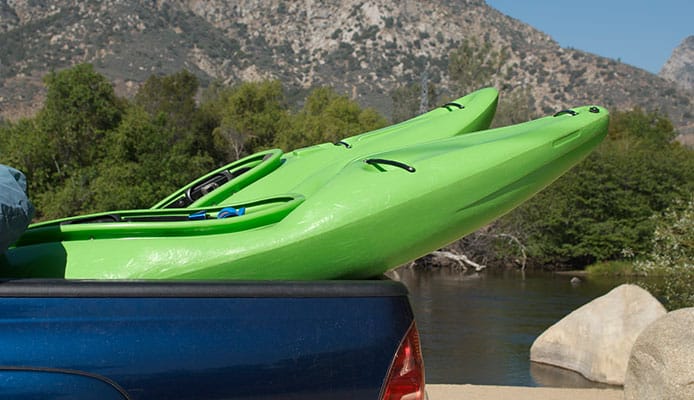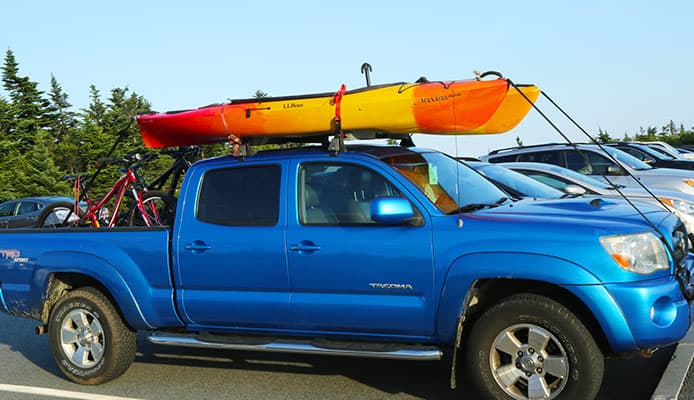
Getting out into nature and away from the stresses of everyday life can be one of the best ways to relax. Kayaking also allows a workout. Getting into nature can sometimes be a little difficult, however, especially when traveling with something large and difficult to maneuver like a kayak. For you to get to the river, ocean, or whatever body of water you choose, chances are you’re going to have to get the kayak in the back of the truck.
Whether you’re a regular paddler or only manage to get the kayak out a couple of times a year, you’re going to need to know how to tie down a kayak in a truck bed. This guide will give you the confidence that your kayak isn’t going to slip out the back of your truck, and you won’t have to resort to looking into kayak repair guides!
Does your Kayak fit your Truck?
There are a few important things to consider when transporting a kayak, namely the size of your kayak, the size of your truck bed, and what fastening devices you have available. I recommend using a cam buckle, these are light and secure, and really a must-have for tying down any loose objects. It’s also important to consider where the anchor points in your truck bed are, positioning your kayak in a way that you’ll be able to lash it down firmly to the anchor points.
The method I’m about to describe is suitable for any kayak under 11 feet. If your kayak is longer there are two different options available to you, either tying a flag to the end of your kayak to alert other drivers that you have an option extending past the rear of your truck or building a mounting system so that you can strap your kayak on a roof rack or above the cab.
Preparing the Truck Bed
First, open the tailgate of your truck and make sure to clear out any debris that may cause damage to your kayak. It may be possible to strap down any loose items to the kayak with the cam buckles, but you want to ensure nothing is rolling loose in the back of the truck. Although not essential, a rubber mat can stop your kayak from slipping in the truck bed. If you have a rubber mat or something similar available, it is good practice to lay it down before storing the kayak.
Getting the Kayak into the Truck
Next, pick up your kayak and slide it into the back of the truck. Some kayaks come designed with handles to make carrying easier, so make sure to use these if possible to make carrying and lifting easier.
Now if possible, you’re going to want to close the tailgate, this means that any part of the kayak that overhangs the end of your trailer is raised above the hood of any car that is driving behind you. If your kayak is too long and you think it is unstable when balanced on a raised tailgate, it’s a better and safer option to tie a flag to the end of your kayak and keep your tailgate lowered.
Now that your kayak is in the back of the truck and you’ve checked where the various anchor points are, you should slide your kayak diagonally across the back of the truck so that the bow is in the front right corner closest to the cab and the stern is angled towards the back-left corner of the truck. This aligns your kayak with the anchor points and maximizes the length and width of the truck bed.
Strapping Your Kayak Down

With your kayak angled towards the anchor points, you will easily be able to attach the cam buckles through the handles or hauling points on the kayak and the anchor points. Run one set of straps horizontally across the kayak, and the other along the length of the kayak, wrapping it around any secure points on the kayak to make it more secure. Sit-top Kayaks often have specific handles that are useful for securing the anchor points.
Although it may be tempting to use bungee straps, there is a greater risk of the straps stretching and becoming unhooked from the anchor points. If you already have a set of bungee straps, you can make them safer and more secure by attaching them to the anchor points with rated carabiners.
Once all straps are in place, make sure to tighten them, creating a snug fit, and hauling your kayak towards the cab end of the truck bed. If you’ve completed all of these steps you know how to safely transport a kayak in a truck bed.
Alternative Transport Systems
For those people looking to carry multiple kayaks or a more long-term solution, several racks and fittings are possible to either build or buy.
Horizontal Extenders
Horizontal bed extenders are available for those looking to secure the back end of their kayak. Although these do make your kayak more secure, there is a major safety point to consider. Remember the extender when parking, you have extended the length of your truck considerably, and there is no point going to all that effort to secure your kayak if you forget about it when your parking. Bed extenders come in a range of sizes and can often be adapted to fit more than one kayak.
Vertical Extenders
Another potential option to consider when transporting your kayak is attaching a vertical bed extender. For those concerned about parking with a kayak out the back of their truck, a vertical bed extender is a good option. With vertical bed extenders, the kayak is lifted above the cab of the truck. This can create more wind resistance, however, is generally considered to look more stable. Also, vertical bed extenders enable the bed of the truck to remain free for your spray skirts, lunch coolers, or any other equipment you may have.
Globo Surf Overview
As you can see there are many ways to tie down or transport your kayak, and with only a small amount of effort, anyone can learn how to transport their kayak in a truck bed. The specific way that you choose to transport your kayak may be down to kayak whether you have a fishing kayak and you need extra storage space, or it’s an extra-long two-person kayak. All this means that you can get out and explore incredible places with peace of mind.
More Skills Guides:

